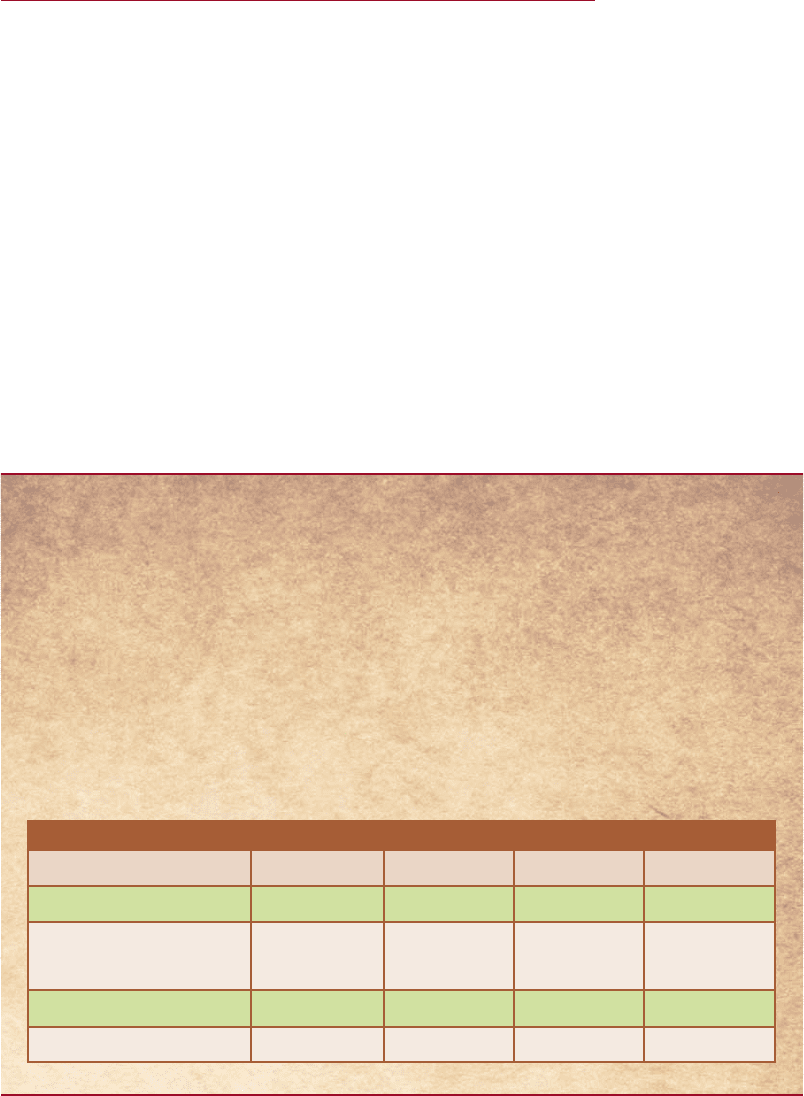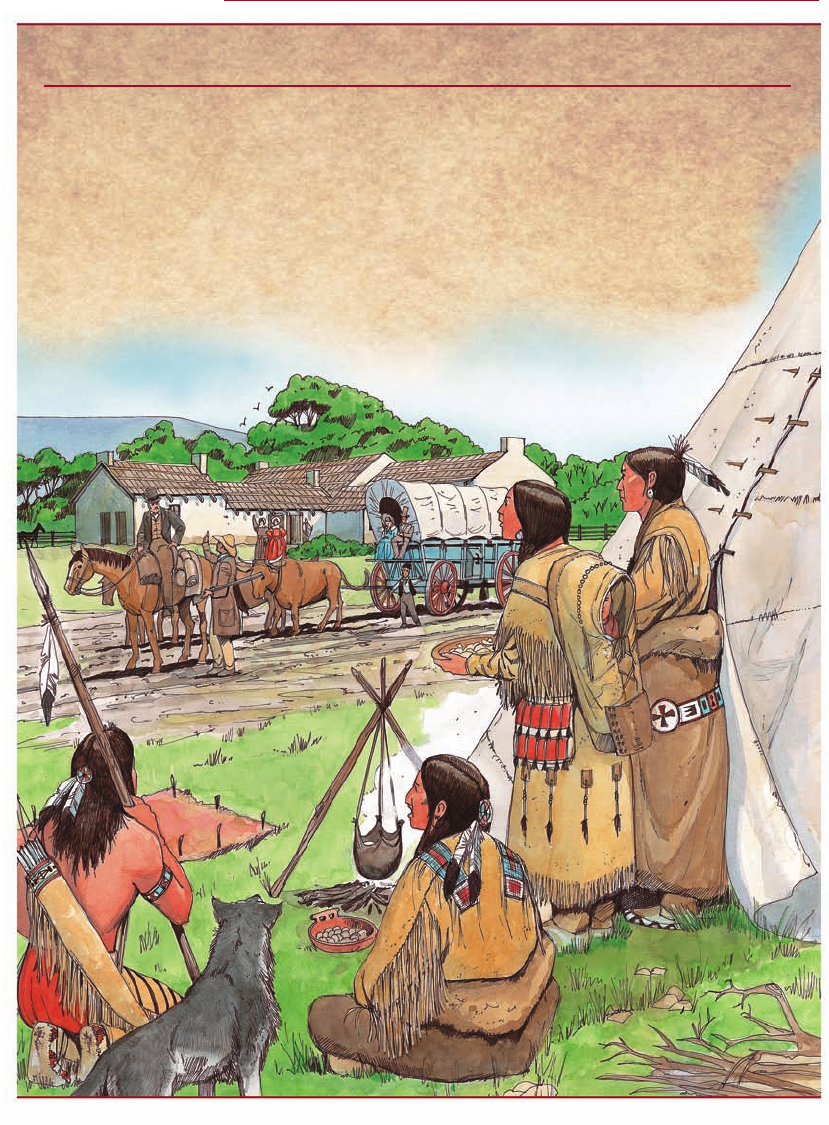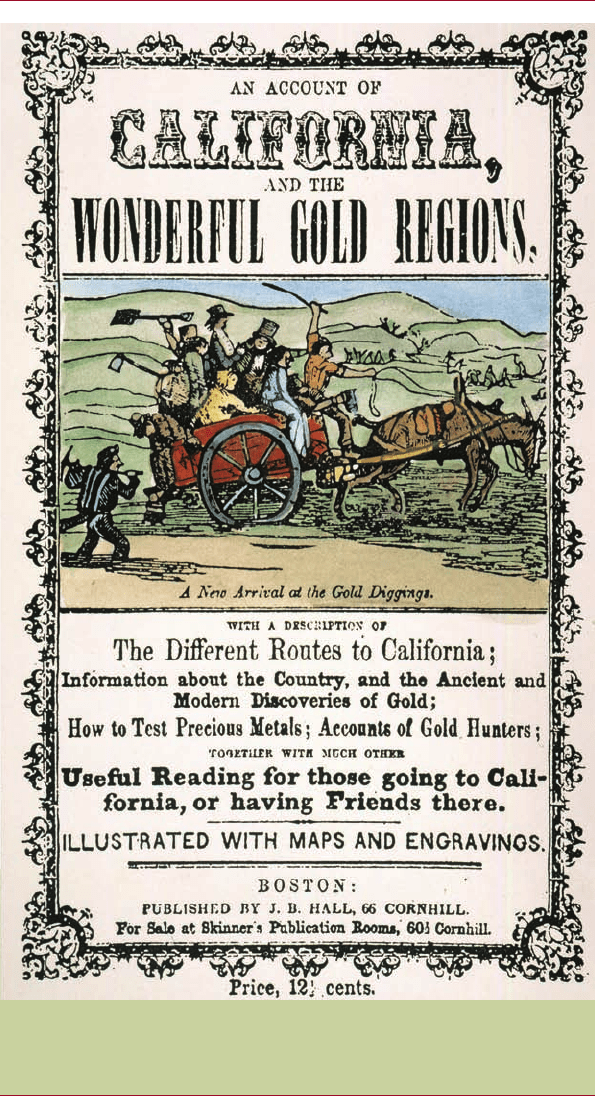McNeese T. Early National America 1790-1850 (Discovering U.S. History)
Подождите немного. Документ загружается.


Early National America
110
thousands of covered wagons and tens of thousands of
American migrants, a series of events drew the attention of
many Americans to the region of the Willamette Valley in the
Oregon Country. As early as 1792 an American ship captain
named Robert Gray had visited the Oregon coast and sailed
into the Columbia River, seeking trade with local Indians.
He named the river after his ship, the Columbia Rediva. Gray
carried with him a letter from President Washington, which
was to serve as an introduction to any emperors or kings of
the lands Gray might reach. Sailing up the Columbia, Gray
soon traded several bolts of cloth and some sheets of copper
with the local American Indians for 3,000 sea otter pelts. He
also traded two nails for 600 beaver skins.
iMMigranTs TO aMeriCa
During the 40-year span between
1790 and 1830, the population of the
United States more than tripled, rising
from 4 million to 13 million people.
Nearly all of that growth was through
natural increase—Americans having
babies and large families. Only about
400,000 foreigners arrived in America
during those decades. It would be
in the years following 1830 that
large numbers of immigrants began
reaching American shores.
In the decade of the 1840s, over
1.5 million immigrants came to settle
in the United States. Nearly half of
these people came from famine-
stricken Ireland. In the 1850s, well
over 2.3 million more people saw
the hope of new opportunity in the
land west of the Atlantic. Why did so
many people come to America during
these years? There are many answers.
As mentioned, a great famine struck
Ireland in 1846. This, added to the
poor working conditions, brought
tens of thousands of people to the
States. From Germany, thousands
fl ed their homeland during the years
1848–49, when a revolution against
political oppression failed.
Many other Europeans came to
America to make their fortunes, or
BOOK_4_Early_National.indd 110 24/6/09 14:57:23

111
The Reach of the American Empire
Other Americans followed. In 1811 John Jacob Astor
from New York established a trading post at the mouth of
the Columbia River, called Fort Astoria. Across the river was
a British fur post, called Fort Vancouver. By the 1820s and
1830s, a number of fur trappers had moved up the Missouri
River from St. Louis, following the path of the Lewis and
Clark Expedition, and into the wooded mountain regions in
search of beaver furs.
Meanwhile, back East, campaigns launched by mission-
ary societies and emigrant organizations were encouraging
people to move to Oregon. In 1831, Hall Jackson Kelley
established one such emigration society to promote perma-
nent settlement in Oregon. He advertised in several eastern
at least to improve their economic
futures. Most new immigrants became
U.S. citizens shortly after arriving.
They made their contributions to
the new land mainly by farming and
by establishing businesses. These
new citizens could be found not
only in big cities, such as New York,
Philadelphia, and Boston, but also
in the West, where they migrated for
land and gold. The chart below shows
the immigration pattern established
during the decades from 1820 to
1860 by those who came to America
from the British Isles, Ireland,
Germany, and Scandinavia. These
nations were among those whose
people fl ocked to the United States.
Major European Immigration to the United States, 1821–60
1821–30 1831–40 1841–50 1851–60
50,000 207,000 780,000 914,000
25,000 75,800 267,000 424,000
6,800 152,000 435,000 951,000
260 2,260 14,440 24,680
Ireland
Britain (England,
Scotland, Wales)
Germany
Scandinavia
BOOK_4_Early_National.indd 111 24/6/09 14:57:25

112
Early National America
new arrivals in OregOn, 1840s
The Whitmans welcomed the arrival
of new emigrants to their mission,
which was set up near present-day
Walla Walla, Washington. Most came
by ox- and horse-drawn wagons. The
2,000-mile (3,200-kilometer) journey
took up to six months. The emigrants
brought with them only what they
needed for the trip and to set up
their new homes. The Indians soon
became overwhelmed by the arrivals.
Some even died of diseases carried
by the emigrants. Inevitably, this
led to conflict and confrontation.
BOOK_4_Early_National.indd 112 24/6/09 14:57:25

113
publications and spoke to interested crowds, lecturing on
the benefits of moving west. Another organizer was Nathan-
iel Wyeth, who extolled the rewards of traveling west along
an overland route.
Wagons Ho!
One of the first missionary efforts began in Oregon when
Jason Lee, a Methodist missionary traveling to Oregon with
Nathaniel Wyeth, established an American settlement in
1834. Dr. Marcus Whitman and his young wife, Narcissa,
were perhaps the most famous missionary couple to move
to Oregon, taking up residence in the Walla Walla region in
1836. The Whitmans were led along the trail by fur trappers
and traders and Narcissa was one of the first white women
to travel the length of the western route, soon to be called
the Oregon Trail. Although their missionary efforts gener-
ally failed, the Whitman mission became a notable stop for
emigrants on the far western end of the Oregon Trail, until
the couple were killed in 1847 by local Cayuse Indians.
In 1841 the first true wagon train, consisting of a dozen
wagons and 70 settlers, traveled along the Oregon Trail to
establish farms and settlements beside Oregon’s Willamette
River. Before the decade was over, more than 100,000 pio-
neers had settled in Oregon.
As early as 1843, Americans in Oregon were organizing a
provisional government, with the intent to petition Congress
for possible annexation and eventual statehood. The follow-
ing year the Democrat candidate for president, James Knox
Polk, a Jackson-like politician from Tennessee, ran on dual
promises to annex Texas and the Oregon Country. In fact,
Polk wanted an American Oregon that extended to the line
of north latitude 54 degrees, 40 minutes, which was close to
the actual border of Russian Alaska. His slogan, “Fifty-four
Forty or Fight!” made his jingoistic intentions ring loud and
The Reach of the American Empire
BOOK_4_Early_National.indd 113 24/6/09 14:57:25

114
Early National America
clear. Once he became president, however, Polk reduced his
reach and, after negotiating with the British, accepted the
49th parallel for Oregon, the one that separates Canada and
the western United States today.
THE MEXICAN-AMERICAN WAR
Although Texas had gained its independence from Mexico in
1836, the Republic of Texas remained a separate nation until
1845, when it was annexed into the Union as an American
state. Following that annexation, the unfriendly relations
between Mexico and the United States worsened. The Mex-
ican government bristled at the American move, and war
between the two nations seemed inevitable. Officially, the
cause of the Mexican–American War was a boundary dispute
between the two countries. While the United States claimed
the southern boundary of Texas to be the Rio Grande, Mexi-
co insisted that the more northern Nueces River was the true
dividing line.
In January 1846, President Polk sent U.S. General Zach-
ary Taylor and 3,500 men to Texas to establish an encamp-
ment along the northern bank of the Rio Grande, a move
that placed them, in the view of the Mexican government,
on Mexican soil. Polk hoped he could goad the Mexicans
into a war. On April 24, 1846, the Mexicans obliged, cross-
ing the Rio Grande and killing or wounding 16 U.S. soldiers.
Polk went immediately to Congress and requested a declara-
tion of war, which he got on May 13. The Mexican–Ameri-
can War had commenced.
Zachary Taylor was the commanding U.S. officer in the
war effort. He was in his 60s, having fought in the War of
1812, the Black Hawk War, and the Seminole Wars with
Jackson. Known as “Old Rough and Ready,” Taylor was well
liked by his soldiers for his courage and easy-going manner.
His strategy was to take the Mexican town of Monterrey and
BOOK_4_Early_National.indd 114 24/6/09 14:57:25

115
The Reach of the American Empire
then march south to Mexico City. After a hard fight, Monter-
rey fell to Taylor. Then President Polk, feeling Taylor lacked
the ability to lead an offensive against Mexico City, replaced
him with General Winfield Scott. Upon taking command,
Scott began marching his army down the eastern coast of
Mexico. His troops took the city of Tampico and then Vera
Cruz, which was the most important Mexican port along
the Gulf Coast. Meanwhile, to the north, U.S. military forces
under the command of Colonel Stephen Austin had suc-
ceeded in capturing Santa Fe (in modern-day New Mexico).
American troops had also captured major coastal cities in
California.
From Vera Cruz, Scott began his campaign inland toward
the Mexican capital. The Americans were met by a spirited
resistance from Mexican armies. Once the American army
arrived in the vicinity of Mexico City, Scott defeated the
enemy at Chapultepec on September 13, 1847. Victory over
the Mexican forces was complete. In the resulting Treaty of
Guadalupe Hidalgo, which ended the war, Mexico lost its
northern territories, stretching from California to Texas—a
total of 529,000 square miles (1,370,000 square kilometers)
of land. These lands would one day become the states of
New Mexico, California, Arizona, Utah, and Nevada.
THE CALIFORNIA GOLD RUSH
Seemingly, no sooner had the Mexican government ceded the
vast region of the Southwest—called the Mexican Cession—
to the United States, then the region of northern Califor-
nia yielded surprising discoveries. A Swiss immigrant called
John Sutter had established a large ranch in the Sonoma Val-
ley. In January 1848, one of his employees, James Marshall,
was working on a new water mill when he saw the sparkle of
glinting metal in the water of the mill’s tailrace. He took the
small bits to Sutter, who determined that they were indeed
BOOK_4_Early_National.indd 115 24/6/09 14:57:25

Early National America
116
Cover of a guide to the gold fi elds of California, 1849.
BOOK_4_Early_National.indd 116 24/6/09 14:57:27

117
gold. The two men agreed to keep the discovery a secret. But
the news leaked out, and soon Americans were flocking west
to California to seek their fortunes.
To some Americans, the discovery of gold on lands that
had only recently been held by the Spanish seemed a gift
from God himself. As noted by historian Lynn Perrigo, one
American promoter wrote:
Why, Sir, did God preserve this whole country more than a
century after its discovery for the English, turning the foot
of the Spaniard to the sunny region of the tropics?… In fine,
why were the immense treasures of California hidden from
the world until she was annexed to this Republic? And tell
me, if anyone can, why it was that the title deed of transfer-
ence had no sooner passed into our hands than she gave up
her mighty secret and unlocked her golden gates?
Regardless, the great California Gold Rush was on.
The Oregon Trail had seen a constant stream of emigrants
through the 1840s, but now the tide became a torrent. The
trail was crowded with several thousands of would-be min-
ers, intent on getting out to California to make their fortune.
With California as their destination, these emigrants fol-
lowed the Oregon Trail to the area of the Great Salt Lake and
then veered south on another route, known as the California
Trail. Many others traveled by sea around South America.
Such a trip was relatively safe and took about six months to
complete, about as long as a trek on the trail across the West
to California. Braver souls sailed south to the Isthmus of
Panama, where they crossed the narrow strait to the western
side and took passage on a ship heading north bound for San
Francisco.
Once in the gold camps along the Sacramento and Amer-
ican Rivers, the lives of the prospectors proved difficult.
The Reach of the American Empire
BOOK_4_Early_National.indd 117 24/6/09 14:57:27

Early National America
118
These men (along with a scattering of women) worked in
local streams where they scooped up gravel in wide-brimmed
pans, then swirled the water and lighter material out using
centripetal force, hoping to leave the heavy metal behind
as their golden yield. Gold fever and the increasing discov-
ery of the metal brought inflation and higher costs for all of
life’s necessities. Miners needed to find close to one ounce
(28 grams) of gold—then worth about $16—per day just
to provide the basics for survival. Many went bust, finding
little gold, but some did make their fortunes. The most per-
manent and far-reaching impact of the 1849 Gold Rush was
that California became a state in 1850.
FROM THE ATLANTIC TO THE PACIFIC
When George Washington took the reins of the presidency
in 1789 the United States was little more than a youthful
republic, populated largely by farmers, who could not imag-
ine their country extending from the Atlantic to the Pacific.
However, within the three generations to follow, America
had become a nation stretching across the continent, a coun-
try reliant on steam power and machines, where democracy
itself had been redefined, and cities had sprung up across
the landscape, planted in the wake of tens of thousands of
Americans moving ever West.
Between 1789 and 1850 the United States had experienced
two large-scale wars and a scattering of Indian conflicts, it
had witnessed the births and deaths of several political par-
ties, but it had emerged stronger and more nationalistic than
ever. Reformers had retooled the nation’s spiritual energies,
while those who followed the lure of rich land in Oregon or
golden riches in California had carried the American flag all
the way to the western ocean. The reach of the United States
had finally caught up with the distant footsteps of its earlier
explorers, Lewis and Clark.
BOOK_4_Early_National.indd 118 24/6/09 14:57:27

119
Yet the America created during the first 50 years of the
nineteenth century had only deferred some of its flaws
and failures. The institution of slavery grew through those
decades until more than 4 million black men, women, and
children were being held in perpetual bondage. It would
remain for a future generation, one that would engage in the
bloodiest war in U.S. history, to finally correct that fault.
The Reach of the American Empire
BOOK_4_Early_National.indd 119 24/6/09 14:57:27
